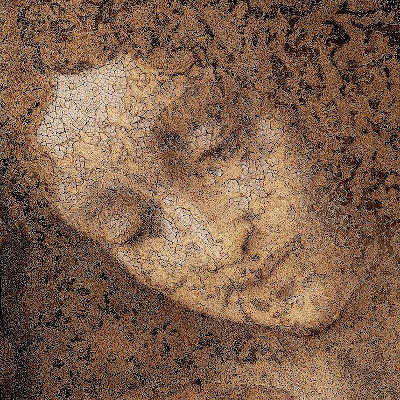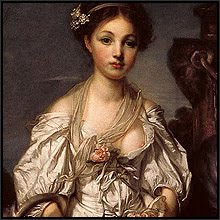 Recent attention has been given to the disciple seated to the right of Jesus. The portrait is of.. who, exactly? Tradition tells us that it is the disciple John, but the restoration (below) reveals a face that, when seen divorced from its context, could readily be described as female. Some sources assign the identity to Mary Magdalene, the woman with the alabaster jar. Is this a shocking heresy? Not necessarily. After all, even if this face is female, Leonardo was painting an image that reflected his own idiosyncratic personal beliefs. So what we are looking at is the artist’s version of events; the truth as he saw it. Exactly why Leonardo should have chosen to portray Mary as a disciple sitting at Jesus' right hand (surely a place not without its significance) is another issue altogether, and addressing it is not my purpose here. What fascinates is the serenity which this face radiates.
Recent attention has been given to the disciple seated to the right of Jesus. The portrait is of.. who, exactly? Tradition tells us that it is the disciple John, but the restoration (below) reveals a face that, when seen divorced from its context, could readily be described as female. Some sources assign the identity to Mary Magdalene, the woman with the alabaster jar. Is this a shocking heresy? Not necessarily. After all, even if this face is female, Leonardo was painting an image that reflected his own idiosyncratic personal beliefs. So what we are looking at is the artist’s version of events; the truth as he saw it. Exactly why Leonardo should have chosen to portray Mary as a disciple sitting at Jesus' right hand (surely a place not without its significance) is another issue altogether, and addressing it is not my purpose here. What fascinates is the serenity which this face radiates.

But this is about two faces of mystery. To visit the second face we need to do some travelling; an extra forty nine million miles farther out from the sun than our own Earth, in fact. On the dusty plains of the planet Mars a vast face seems to be regarding us (below). This is not the more famous and supposed artificially constructed ‘face’ in the Martian Cydonia region, but a face of pure and near-perfect pareidolia - a construction of chance. Hills, cliffs and gullies conspire together to mold from the Martian landscape a human face so compelling that, even though we know that it is contrived by chance, our brains go on insisting to us that we truly are gazing at a ‘real’ face. Try looking at it through half-closed eyes: it becomes even more real. We might even find this face with its crown of Martian cliffs rather disturbing, although it’s features are hardly hideous, or even ugly. Why should this be so?
 Perhaps the unnerving quality which this Martian face seems to possess is exactly because it is so real, and yet is the result of chance. The more radically convincing an example of pareidolia is, the more it seems to have a life-force of its own: a something which has invaded our reality, and is trying to make its presence known to us. After all, if a face this real appeared in wet sand in our driveway – or even on a slice of toasted cheese – we’d be auctioning it on eBay.
Here are two faces. One is sublime, the mysterious product of an artist’s genius. The other is a counterfeit, created naturally, yet unnatural: a deception which is dependent upon interaction with the human mind for its existence, as perhaps are many such mysteries.
Perhaps the unnerving quality which this Martian face seems to possess is exactly because it is so real, and yet is the result of chance. The more radically convincing an example of pareidolia is, the more it seems to have a life-force of its own: a something which has invaded our reality, and is trying to make its presence known to us. After all, if a face this real appeared in wet sand in our driveway – or even on a slice of toasted cheese – we’d be auctioning it on eBay.
Here are two faces. One is sublime, the mysterious product of an artist’s genius. The other is a counterfeit, created naturally, yet unnatural: a deception which is dependent upon interaction with the human mind for its existence, as perhaps are many such mysteries.
Hawkwood
Artist: Leonardo da Vinci Work: The Last Supper, 1498 (completed) Medium: Tempera Location: Santa Maria delle Grazie refectory, Milan Sources: 'Leonardo' , by Bruno Santi. Constable. 1978 'The Templar Revelation' , by Lynn Picknett and Clive Prince. Bantam Press. 1997 Mars Global Surveyor orbiter image from NASA



































No comments:
Post a Comment
You are welcome to share your thoughts..